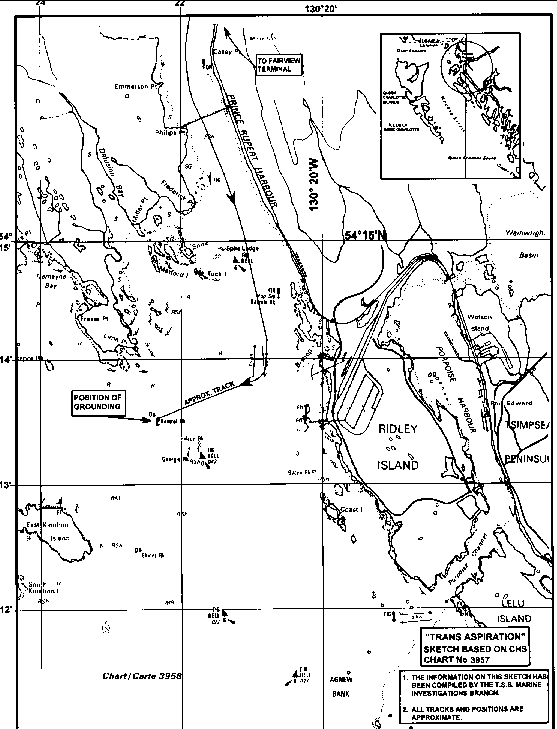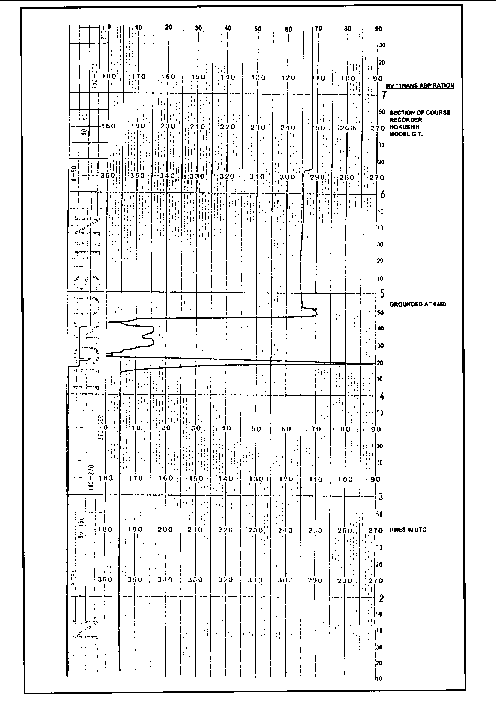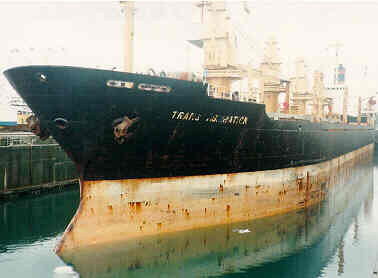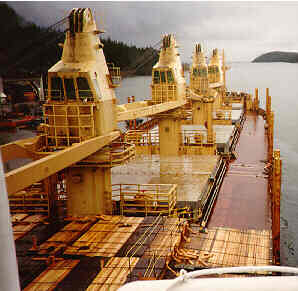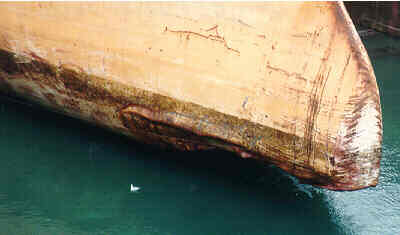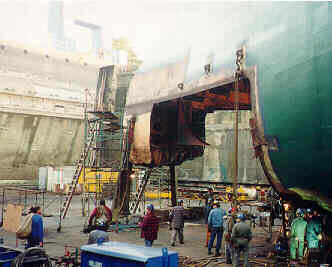Grounding
bulk carrier "TRANS ASPIRATION"
Kestrel Rock, Prince Rupert Harbour
British Columbia
The Transportation Safety Board of Canada (TSB) investigated this occurrence for the purpose of advancing transportation safety. It is not the function of the Board to assign fault or determine civil or criminal liability. This report is not created for use in the context of legal, disciplinary or other proceedings. See Ownership and use of content. Masculine pronouns and position titles may be used to signify all genders to comply with the Canadian Transportation Accident Investigation and Safety Board Act (S.C. 1989, c. 3).
Summary
The "TRANS ASPIRATION" departed Prince Rupert, British Columbia, on 02 December 1993 and was proceeding toward the open sea, under the conduct of a pilot, when she grounded on Kestrel Rock during a period of heavy rain. Damage was sustained to the underwater section of the bow. There was no pollution.
The Board determined that the "TRANS ASPIRATION" grounded on Kestrel Rock because the vessel's position was not established by the pilot before a critical course alteration, and the vessel's speed was not adapted to the prevailing circumstances and visibility. A contributing factor was the lack of exchange of information between the bridge team and the pilot.
1.0 Factual Information
1.1 Particulars of the Vessel
| "TRANS ASPIRATION" | |
|---|---|
| Official number | 17166-87-A |
| Port of registry | Panama |
| Flag | Panamanian |
| Type | Bulk carrier |
| Gross TonsFootnote 1 | 15,966 |
| Length | 175.11 m |
| Breadth | 26.01 m |
| Draught | FFootnote 2: 9.00 m A: 9.50 m |
| Cargo | 24,479 tonnes of copper concentrate and wood products |
| Crew | 27 |
| Built | 1977, Marugame, Japan |
| Propulsion | One seven-cylinder Sulzer diesel engine rated 8,496 kW, driving a single fixed-pitch propeller |
| Owners | Wah Tung Shipping Agency Co. Ltd., Wanchai, Hong Kong |
1.1.1 Description of the Vessel
The "TRANS ASPIRATION" is a typical bulk carrier with a bulbous bow. The crew accommodation, bridge and engine-room are located aft. The vessel has five sets of double-bottom tanks and five sets of side tanks. The centre double-bottom tanks Nos. 1 to 4 are used for the carriage of fuel oil. The forepeak tank is common with the bulbous bow compartment and extends aft to the collision bulkhead.
The navigation bridge has open wings. The distance from the bridge to the bow is 144 m and, from the bridge to the stern, 31 m.
1.2 History of the Voyage
The "TRANS ASPIRATION" completed loading cargo at 1440Footnote 3, 02 December 1993. The pilot had been ordered for 1900. At 1730, before the pilot's arrival, all wheel-house and engine-room equipment was tested satisfactorily.
The pilot boarded at 1955 and the "TRANS ASPIRATION" departed Fairview Terminals, Prince Rupert, British Columbia, at 2012, bound for Japan. In the wheel-house were the pilot who had the conduct of the vessel, the master who was observing and keeping a look-out between the forward port wheel-house windows and the port side radars, the officer of the watch (OOW) who was standing by the telegraph located at the starboard side and making entries in the bridge movement book, and a helmsman.
The weather at departure was south-easterly winds at 40 knots with moderate rain and a rough sea. Visibility was one to two miles. The tide was ebbing.
On clearing the dock, the vessel was swung 180 degrees to starboard with the assistance of two tugs. When the vessel was aligned in the main channel, the tugs were dismissed and full harbour speed was rung on the telegraphs at 2021. The engines were on engine-room control and the vessel was in the hand-steering mode. The pilot reported the departure of the vessel to Prince Rupert Vessel Traffic Centre (VTC) on very high frequency radiotelephone (VHF R/T) channel 71.
After passing Casey Point, Kaien Island, courses were steered to make good a track of 162° (T) to Spire Ledge light and bell buoy D47. Course was then altered to approximately 185° (T). When the vessel was steady on the new heading, Holland Rock light was observed to be right ahead. Just before the vessel passed Barrett Rock, a heavy rain squall was encountered, decreasing visibility.
1.2.1 Subsequent Events - According to the Pilot
The squall intensified to the point that visibility was reduced to almost zero. From his vantage point at the port rotating clear view screen, the only light the pilot could see was a faint glow over Ridley Terminals.
Moving to the port radar units, all he could distinguish was a vague outline of East Kinahan Island. He tried to enhance the picture but was unable to do so. Returning to the clear view screen, he tried to identify Georgia Rock buoy but could not see it. He returned to the port radar units and discovered that, although the panel lights on both sets were operating, the screens were blank.
Moving to the radar on the starboard side, he discovered that it was switched off. He requested that the radars be attended to. Going out to the starboard bridge wing, he searched with binoculars for navigational aids.
Believing that the vessel was south of Georgia Rock buoy, he ordered starboard helm. After a course alteration of 10 to 15 degrees, he was unsure of the position of the vessel and slowed the rate of swing. There was still no operational radar but, on peering outside again from the starboard bridge wing, he sighted East Kinahan Island light shining faintly about two points (22½°) on the starboard bow. Moving to the port wing of the bridge, he sighted a flashing green light just forward of the port beam. He assumed that it was Ridley Island light and bell buoy D27.
Starboard 10° of helm was ordered and then the rate of swing was slowed as the pilot had not yet identified Georgia Rock buoy. As the light on East Kinahan Island became brighter, he became concerned that the vessel was turning too slowly and was approaching too close to the island. The proximity to and the brightness of the flashing green light suddenly made him realize that he had mistaken Georgia Rock buoy for Ridley Island buoy and that the vessel was passing on the wrong side of Georgia Rock buoy. The orders for amidships and port 10° were given immediately but, about 10 to 20 seconds later, the vessel, travelling at approximately 10 knots, grounded on Kestrel Rock.
Seconds before the grounding, it was reported to the pilot that a radar set was operational but the pilot had no opportunity to view the display before the vessel struck.
1.2.2 Subsequent Events - According to the Bridge Watch
Although moderate rain was falling after the vessel passed Spire Ledge buoy, the lights on Ridley Terminals were visible as were the Georgia Rock and Ridley Island light and bell buoys and the light on East Kinahan Island.
Both radar units on the port side had been on and fully operational since departure from Prince Rupert. The starboard radar was turned on but was in the stand-by mode.
At 2042, when passing Prince Rupert Grain Terminal, the OOW plotted the position of the vessel by radar, laid the position down on the chart, and returned to his station at the telegraph. The rain was very heavy at this time. Both Georgia Rock and Ridley Island buoys could still be observed visually but they could not be detected on the Plan Position Indicator (PPI) because of rain and sea clutter. Both East Kinahan Island and Ridley Island showed up well on the PPI.
The master looked at the charted position but the pilot did not. Neither the master nor the OOW brought the position to the pilot's attention.
At about the same time as the OOW plotted the vessel's position abeam of Prince Rupert Grain Terminal, the pilot ordered starboard 20° of helm to bring the vessel to a heading of 250° (G).
At 2050, the "TRANS ASPIRATION", reportedly moving ahead at about 10 knots, struck Kestrel Rock. The pilot immediately ordered hard-a-port, stop engines and then full astern. The vessel came to rest in position 49°13′18″N,130°22′18″W, heading 245° (G).
At 0311, on 03 December, the vessel was refloated with the assistance of tugs and went to an anchorage in Prince Rupert Harbour.
Following a damage survey, the vessel was allowed to proceed, via the inside passage, to dry dock in Esquimalt, British Columbia.
1.3 Injuries to Persons
No one was injured.
1.4 Damage
1.4.1 Damage to the Vessel
Damage was limited to the underwater area forward of the collision bulkhead. There was severe buckling, crushing and fracturing to frames, transverse floors, the centre line girder and bow shell plating within that area. The forepeak tank had been breached.
The bulk cargo stowed in cargo hold No. 1, at about half height against the collision bulkhead, assisted in shoring and strengthening the bulkhead.
1.4.2 Environmental Damage
There was no environmental damage.
1.5 Certification
1.5.1 Vessel
The vessel was certificated, manned and equipped in accordance with existing regulations.
1.5.2 Personnel
Both the master and the OOW held qualifications appropriate for the class of vessel on which they were serving and for the voyage being undertaken.
The pilot held qualifications as a Class I Pilot to operate under the jurisdiction of the Pacific Pilotage Authority. As a requirement for his certification, the pilot has completed Simulated Electronic Navigation (SEN) radar courses, levels 1 and 2 (SEN 1 and SEN 2). He had not taken the Automatic Radar Plotting Aid (ARPA) course. The successful completion of such a course was not a requirement when he qualified as a pilot.
1.6 Personnel History
1.6.1 Master and Officer of the Watch
The master had served in his present capacity for more than two years. He had been master of the "TRANS ASPIRATION" for one year, during which time he had made three previous trips to Prince Rupert and transited north of the Kinahan Islands.
The OOW had served in that capacity for three years. He had joined the "TRANS ASPIRATION" on 14 June 1993 and had made two previous trips to Prince Rupert on the vessel and two trips on another vessel.
The master and crew were well rested, the vessel having been in port since the morning of 29 November 1993.
1.6.2 Pilot
The pilot started working for the Pacific Pilotage Authority in April 1981. He is a senior pilot and has made numerous trips in and out of Prince Rupert over the years. The pilots of the Pacific Pilotage Authority work duty rosters of 21 days on and 10 days off. This was his first day of return to duty.
1.7 Environmental Information
1.7.1 Forecasts
At 1645, 02 December 1993, the Pacific Weather Centre of Environment Canada downgraded a storm warning to a gale warning for Dixon Entrance West. Winds were forecast to be southerly 25 knots shifting to north-westerly 25 knots to gales 35 knots late the following morning.
1.7.2 Weather as Recorded by the Vessel
Conditions experienced on sailing were as follows: winds southerly at approximately 40 knots with the visibility one mile to two miles in rain. When in the vicinity of Prince Rupert Grain Terminal, heavy rain with similar visibility was experienced.
At the time of the grounding, the rain had eased off and the visibility improved to two to three miles. The wind was south-easterly at 22 knots to 27 knots with moderate seas.
1.7.3 Weather as Reported by the Pilot
When in the vicinity of Barrett Rock, squally conditions were experienced with heavy rain and the wind south-south-easterly at 45 to 50 knots. A short time later, the rain became heavier with visibility reduced to near zero. Seas were moderate to rough. Conditions improved just before the grounding.
1.7.4 Weather as Recorded at Shore Stations
1.7.4.1Ridley Island Loading Terminal
The printout from the anemometer alarm located at Ridley Island Loading Terminal indicated that winds in excess of 39 knots were experienced at about the time of the grounding.
1.7.4.2Triple Island Light Station (Pilot Boarding Station)
At 1840, southerly winds at 32 knots and 2.5 m seas were recorded. At 2100, the wind veered and, at 2140, conditions moderated to westerly winds at 22 knots with moderate seas, 1.3 m in height.
1.7.5 Tides and Tidal Stream
1.7.5.1Prince Rupert Harbour
Low water at Prince Rupert was predicted to be at 2140, 02 December 1993, with a height above chart datum of 1.0 m. The next high water was predicted to be at 0400, 03 December, with a height of 5.0 m above chart datum.
The tides in the Prince Rupert Harbour area flow into and out of the harbour in a northerly/southerly direction at rates of between 1½ and 2½ knots.
The "TRANS ASPIRATION" grounded 50 minutes before low water and was refloated with the aid of tugs 49 minutes before the next high water.
1.7.5.2 Triple Island
Times of tides for Triple Island are as for Prince Rupert Harbour.
Sailing Directions warn that, between Triple Island and Hanmer Rocks, the flood tide sets east-south-easterly at up to 1½ knots and, in the vicinity of Triple Island, the tidal streams are strong and irregular. They also warn that tidal streams are greatly affected by prevailing winds.
1.8 Navigation Equipment
1.8.1 Vessel
The "TRANS ASPIRATION" is equipped with the following navigational aids:
- one magnetic reflecting standard/steering compass;
- a master gyrocompass located at the steering position, complete with autopilot, with repeater compasses at the centre wheel-house window and on the port and starboard bridge wings. A course recorder is connected to the master gyro;
- rudder and revolution indicators at the centre wheel-house and on each bridge wing;
- three radars (X band), two of which are located on the port side of the wheel-house and one on the starboard side;
- a satellite navigator and a Loran C, each with digital latitude and longitude readout;
- one echo-sounder;
- a comprehensive chart inventory for the area: Canadian, British and American. Full sets of British and American Sailing Directions for the British Columbia coast. The appropriate chart for the area, corrected to date, was in use;
- two VHF R/Ts.
1.8.2 Serviceability, Procedures and Use of the Navigation Equipment
1.8.2.1 Radars
The bridge team reported that the port radar units, which operate with the same transmitter/receiver but with independent tuning controls, were both tuned in and operational throughout.
The pilot reported that, when attempting to retune both sets during the heavy rain squall, he adjusted the rain and sea clutter controls only to find that the screens became flooded with sea clutter. On looking at the sets a short time later, only the panel lights were on and the PPI screens were blank.
The vessel's engineers reported that there had been no power blackout of any description which might account for the radars having been shut off.
All three radar sets were found to operate normally while the vessel was alongside Fairview Terminals on 04 December 1993.
On 10 December 1993, an operational evaluation was conducted on the radar equipment by Canadian Coast Guard technicians while the vessel was secured at Ogden Point, Victoria, British Columbia. The evaluation was limited to the control and switching functions of all three radars. The evaluation concluded that all sets were operating normally. The operation of the anti-clutter/rain controls had the normal effect of differentiating the leading edge of large, solid targets but could not be evaluated on precipitation because of the good weather conditions at the time.
1.8.2.2 Gyrocompass and Course Recorder (See Appendix B)
The course recorder graph indicates that it was reset at approximately 1710, 02 December 1993, and the trace shows that, while the vessel was alongside the dock, the master gyro was reading approximately one degree high (1° W).
The crew reports that the repeaters were synchronized with the master gyro and checked before sailing, while the pilot reports that the repeaters were a further one degree or more high. They were found to be properly synchronized on 03 December when the vessel was alongside Fairview Terminals.
The course recorder indicates that the "TRANS ASPIRATION" swung to starboard after leaving the dock, coming to a heading of 180° briefly before steering between 164° and 168° while transiting between Casey Point and Spire Ledge. At 2040, an alteration to starboard was made coming briefly to 180° at 2042:30 and to 190° at 2044:30. At 2045, the course was again altered to starboard until the vessel was on a heading of 250° at 2047. The "TRANS ASPIRATION" grounded approximately three minutes later, heading 245°.
1.8.3 Shore Navigational Aids
Barrett Rock light was reported extinguished at 0149, 02 December 1993, and was the subject of Notice to Shipping No. W2422. It was back in operation at 0524, 03 December. All other lighted navigational aids in the vicinity of the grounding were operating as advertised. Both Georgia Rock buoy D43 and Ridley Island buoy D27 have the same light characteristics. The buoys are 1.3 miles apart.
1.9 Prince Rupert Grain Terminal and Ridley Terminals
The terminals each had a ship secured alongside and both the terminals and ships were lighted. In addition to terminal lighting, Ridley Terminals displays flashing yellow lights at the top of the loading towers, as shown on the chart.
1.10 Radio Communications
Following the grounding, the pilot reported to Prince Rupert VTC, and requested tugs to assist in refloating the vessel.
1.11 Vessel Traffic Centre
Prince Rupert VTC is not equipped with radar equipment to monitor the passage of vessels into and out of the harbour.
1.12 Pilotage in Prince Rupert
Prince Rupert lies in compulsory Pilotage Area 4 of the Pacific Pilotage Authority. Pilots are rotated through the port of Prince Rupert, with two pilots at a time spending one week in the area. The pilot on the "TRANS ASPIRATION" was dispatched to Prince Rupert in addition to the two other pilots because an assignment requiring his expertise as a senior pilot was scheduled for the following day.
The pilot's flight from Vancouver was delayed as the aircraft required de-icing at Kitimat, British Columbia. He was approximately one hour late on boarding the vessel.
1.13 Voyage Planning
There is no recommended route for vessels transiting between Triple Island and Prince Rupert other than for deep-draught vessels. The "TRANS ASPIRATION" was not classed as a deep-draught vessel.
During adverse weather conditions, it is not practical for pilots to disembark at Triple Island. The pilot advised the master that he had chosen to proceed north of the Kinahan Islands and to disembark north of the Lucy Islands. The pilot had taken this route on numerous previous occasions.
1.14 Navigation with Pilot on Board
The International Convention on Standards of Training, Certification and Watchkeeping for Seafarers, 1978 (STCW) and the IMO Code of Nautical Procedures and Practices state, in part, under the heading "Basic Principles to be Observed in Keeping a Navigational Watch":
10. Navigation with pilot embarked
Despite the duties and obligations of a pilot, his presence on board does not relieve the master or officer in charge of the watch from their duties and obligations for the safety of the ship. The master and the pilot shall exchange information regarding navigation procedures, local conditions and the ship's characteristics. The master and officer of the watch shall co-operate closely with the pilot and maintain an accurate check of the ship's position and movement.
The pilot reported that, after he boarded, he briefed the master on the intended route and on where he would be disembarking. No further exchange of information took place regarding the characteristics of the vessel.
The master confirmed the information exchange on routing and disembarking; however, he also reported that the pilot had inquired as to the manoeuvring characteristics of the vessel. The pilot was shown the manoeuvring card fixed to the starboard console which gives rpm and harbour speeds for the various telegraph positions.
The following items were posted in the wheel-house and were plainly visible:
- manoeuvring characteristics, showing turning times and distances, and stopping times and distances;
- the master's standing orders; and
- bridge instructions based on the STCW. These included the recommended conduct of bridge officers with a pilot on board.
1.15 Forward Mooring Party
The chief officer and the mooring party on the forecastle head were instructed to stand by the anchors in case of emergency after the mooring lines had been stowed away for sea. The pilot did not know that the mooring party was still on the forecastle and that a member of the party could have readily supplemented the bridge look-out; none of the forward party had been appointed as a look-out. Communication with the forecastle was by handheld walkie-talkies.
1.16 Wheel-house Windows
The pilot reported that, once the vessel was under way, the wheel-house windows were continually fogged up with condensation, requiring a seaman to be called to the wheel-house to wipe them clean. It was also necessary to leave both wheel-house doors open once the windows were cleaned. The same problem was reported by the pilots who piloted the vessel to Victoria. The ship's crew denied that the problem existed.
2.0 Analysis
2.1 Introduction
As there is little margin for error while piloting outbound Prince Rupert Harbour using the channel north of the Kinahan Islands, particularly in bad weather, it is essential that effective bridge resource management (BRM) be practised.
2.2 Situational Awareness and Information Processing
Situational awareness can be defined as all the knowledge that is accessible and can be integrated into a coherent picture, when required, to assess and cope with a situation. To maintain situational awareness, a person scans for signals or cues which can be interpreted to reveal important information, such as location, speed, and the presence of hazards. A marine pilot has to maintain situational awareness to maintain safe control of the ship.
When performing tasks with which they are familiar, persons know the normal flow of activities and action alternatives and, therefore, do not always consult the complete set of defining attributes before acting in a familiar situation.
There is a natural tendency to refrain from using all the cues available. Instead, a person who expects certain cues will use those cues to quickly confirm his/her assessment of the situation and take what is apparently appropriate action without referring to other information which may corroborate or conflict with the evaluation.
When persons are stressed by, for example, the difficulty of a situation or pressures for on-time performance, there is a tendency for their attention to become even more narrowed so that even those cues which are present are missed, ignored or discounted. Stress can also affect the perception of time. Under stressful conditions, people overestimate the amount of time which has passed.
The pilot reported that he could not see any lights except Ridley Terminals as a faint glow when south-west of Barrett Rock. However, Prince Rupert Grain Terminal was closer, lighted, and also had a vessel alongside. It is therefore probable that he misidentified the origin of the faint glow in the reduced visibility. This would account for altering course too soon and for his assumption that the green flashing buoy to port was Ridley Island buoy instead of Georgia Rock buoy.
When a course of 250°, from an alter-course position off Prince Rupert Grain Terminal, is laid off on the chart, the course line runs through the vicinity of Kestrel Rock. However, the pilot believed that the vessel was abeam of Ridley Terminals, some five cables ahead, and the same course of 250° laid off from that area would bring Georgia Rock buoy ahead, as the pilot had intended.
The pilot lost his situational awareness in that he misidentified two buoys located 1.3 miles apart, most probably as a consequence of confusing the loom of the terminal lights. The belief that the vessel was about five cables ahead of her actual position also indicates that the pilot had over-estimated the passage of time.
Several factors could have contributed to the pilot's over-estimating the passage of time: the poor visibility, the pilot's late arrival on board due to a delayed flight, his concerns about disembarking in rough sea conditions or being carried on to the next port of call should it have been impossible to disembark, and his concerns about the next morning's assignment. All of the foregoing could have produced enough stress or pressure to narrow the pilot's attention and distort his perception of time passing.
2.3 Bridge Resource Management (BRM)
The concept of BRM is to emphasize teamwork to optimize the use of all available resources, including equipment, written information, procedures, and personnel, to foster effective decision making during critical phases of a passage.
Had BRM been practised, courses would have been laid off on the chart with the times of course alterations. The vessel's progress could have been closely monitored throughout by the bridge team and the 2042 position brought to the pilot's attention.
Additionally, had either the OOW or the pilot laid off the course of 250° (T) from the position of 2042, it would have been apparent that the vessel was heading directly toward Kestrel Rock.
As it was, the bridge team testified that it was not aware that the pilot was having difficulty in determining the vessel's position or in sighting and identifying the lighted buoys.
Both the master and the OOW, individually, had identified Georgia Rock buoy and East Kinahan Island light and assumed that the pilot had also done so. The OOW had also visually identified Ridley Island buoy. Had the principles of BRM and good seamanship been observed, the sighting of these lights would have been reported as part of a free flow of information.
Mariners have confidence in the knowledge and skills of marine pilots. The common or normal procedure is for masters and ship officers to trust a pilot and to stay out of his way. There is a reluctance to do anything which may be considered a distraction for or interference with a pilot, which is exactly what took place on the bridge of the "TRANS ASPIRATION", where he was trusted implicitly.
To gain a pilot's perspective of ship's crew/pilot interaction, representatives of the Pacific Pilotage Authority and British Columbia Coast Pilots Limited cited examples of ships calling at British Columbia ports with unqualified and unskilled officers and crew, language problems, and poor attitudes. These attributes were considered as being partly the reason for the lack of communication between pilots and crew in general. Although none of these factors are relevant to the "TRANS ASPIRATION", pilots become conditioned to these circumstances.
2.4 Navigational Aids
2.4.1 Radars
Because the vessel's radars were later found to be operating normally, the reason the radar PPI screens flooded with sea clutter while the pilot attempted to retune the radars was most likely that the tuning controls were not operated as designed.
The fact that the PPI screens were blank and the panel lights were still on could be attributed to the brilliance control being inadvertently turned full off. Furthermore, with the sets in question, when the rain clutter control is turned full on, the screen appears blank except for the trace of the heading marker, which may be very dim, depending on the amount of brilliance applied.
Alternatively, a temporary power blackout would result in the picture being lost until the sets warmed up again, but the panel lights would come back on instantly. The engineers reported no such blackout.
The pilot had not taken the ARPA training course. He was familiar with the sets in question; however, pilots use many different types of radars in the course of their job.
2.4.2 Satellite Navigator and Loran C
Because the navigation watch experienced no difficulty in obtaining a position, they were unaware that the pilot had assumed that the vessel was five cables ahead of her actual position. Had the watch known of the pilot's assumption, the position on the chart could have been brought to the pilot's attention and checked by a position obtained from either the operational satellite navigator or Loran C.
2.4.3 Course Recorder
The course recorder trace is not consistent with the pilot's account of course alterations; for example, the trace indicates that the vessel swung from a heading of 190° (G) to a heading of 250° (G) just before the grounding in approximately two minutes with no real indication of slowing the swing as reported by the pilot.
2.5 Seamanship
Good seamanship would dictate that headway should have been reduced or all way taken off the vessel until such time as the position could be ascertained.
3.0 Findings
- The adverse weather conditions and the anticipated rough seas at Triple Island were the deciding factors in determining the vessel's route.
- The vessel was travelling at a speed not adapted to the prevailing circumstances and visibility.
- The pilot, although uncertain of the vessel's position, did not share his uncertainties with the navigation watch.
- Both Georgia Rock buoy and Ridley Island buoy have the same light characteristics.
- The pilot mistook Georgia Rock buoy for Ridley Island buoy and made a bold and premature alteration of course.
- The navigation watch had plotted the position of the vessel by radar but did not bring it to the pilot's attention.
- The navigation watch had sighted navigational aids for which the pilot was searching but did not convey this information to the pilot.
- The navigation watch reported that the radars were operating satisfactorily at all times.
- The pilot reported that the radars he was using were not operating satisfactorily and that he was unsuccessful in retuning them.
- Although there was a mooring party on the forecastle, no dedicated look-out was assigned forward.
3.1 Causes and contributing factors
The "TRANS ASPIRATION" grounded on Kestrel Rock because the vessel's position was not established by the pilot before a critical course alteration, and the vessel's speed was not adapted to the prevailing circumstances and visibility. A contributing factor was the lack of exchange of information between the bridge team and the pilot.
4.0 Safety Action
4.1 Safety Action Taken
4.1.1 Light Characteristics
In January 1995, as a result of a cyclical review process of navigational aids, the Canadian Coast Guard (CCG) decided to change the light characteristics of Georgia Rock buoy (D43) to quick-flashing green (QG), CHS Chart No. 3958 refers.
4.1.2 Pilot Passage Planning
In two 1991 occurrences (TSB Report Nos. M91L3015 and M91L3012), the Board found that the involved vessels had left the navigation channel when the pilots had prematurely made the usual alteration of course. Neither the pilot nor the officer of the watch had recognized that the vessel was not on the intended course before the course change. These navigation errors could have been detected if passage planning had been in place and the progress of the vessel had been monitored by the bridge team. As a result, the Board recommended that:
The Department of Transport require that the pilotage authorities publish official passage plans for compulsory pilotage waters and make them available to masters to facilitate monitoring of the pilot's actions by the vessel's bridge team.
Transportation Safety Recommendation M94-34 (issued December 1994)
In response, the Department of Transport stated that the Pilotage Act did not provide for the Department of Transport to require pilotage authorities to take action of the nature recommended. The Pacific Pilotage Authority also did not agree with passage plans; it expressed concern that there would be a question of liability, both for the pilot and for the Authority, should a ship following that plan become involved in an accident.
However, supported in part by the circumstances of this occurrence, the Board still felt that close monitoring of a vessel's progress in accordance with an agreed passage plan would enhance the safe conduct of a vessel. As such, in its Safety Study of the Operational Relationship Between Ship Masters/Watchkeeping Officers and Marine Pilots, the Board recently recommended that:
The Department of Transport require that pilots, as part of their initial hand-over briefing:
- obtain the master's agreement to the intended passage plan; and
- invite the bridge team's support by having the officer of the watch plot and monitor the vessel's position at regular intervals and report the position to the pilot with respect to the agreed passage plan.
This report concludes the Transportation Safety Board's investigation into this occurrence. Consequently, the Board, consisting of Chairperson John W. Stants, and members Zita Brunet and Maurice Harquail, authorized the release of this report on .
Appendices
Appendix A - Sketch of the Area Showing Position of Grounding
Appendix B - Course Recorder Trace
Appendix C - Photographs
Appendix D - Glossary
- A
- aft ARPA - Automatic Radar Plotting Aid
- BRM
- bridge resource management
- F
- forward
- G
- Gyro (degrees)
- kW
- kilowatt(s)
- IMO
- International Maritime Organization
- m
- metre(s)
- N
- north
- OOW
- officer of the watch
- PPI
- Plan Position Indicator
- PST
- Pacific standard time
- rpm
- revolutions per minute
- SEN
- Simulated Electronic Navigation
- SI
- International System (of units)
- STCW
- International Convention on Standards of Training, Certification and Watchkeeping for Seafarers, 1978
- T
- True (degrees)
- TSB
- Transportation Safety Board of Canada
- UTC
- Coordinated Universal Time
- VHF R/T
- very high frequency radiotelephone
- VTC
- Vessel Traffic Centre
- W
- west
- °
- degree(s)
- ′
- minute(s)
- ″
- second(s)

